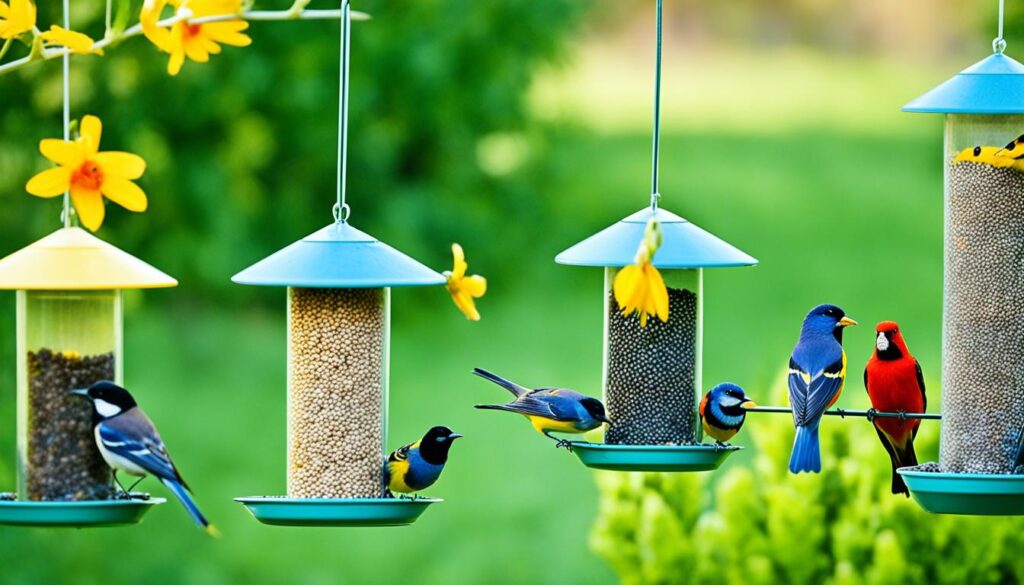Safflower seeds are vital for many songbirds in the U.S. They are perfect for cardinals, bluejays, and more. These seeds have a hard shell, which is tough for some birds. Yet, they are loved by many.
Cardinals, bluejays, chickadees, and others enjoy these seeds because they are nutritious. Safflower seeds have 38% fat, 16% protein, and 34% carbohydrates. This makes them a great energy source for our winged friends. Plus, they keep squirrels away from feeders, making them ideal for bird watchers.
Key Takeaways
- Safflower seeds are a preferred food source for a variety of backyard birds, including cardinals, bluejays, chickadees, nuthatches, grosbeaks, titmice, doves, indigo buntings, finches, and even house sparrows.
- Safflower seeds are highly nutritious, containing 38% fat, 16% protein, and 34% carbohydrates, making them an excellent energy source for birds.
- Safflower seeds have the advantage of deterring squirrels and other nuisance animals from dominating the bird feeder.
- Safflower seeds come in a unique shape and size, offering a distinct option in wild bird feed mixes.
- Proper placement and introduction of safflower seeds in your backyard can help attract a diverse range of bird species.
Introduction to Safflower Seeds for Birds
Safflower seeds are a great pick for feeding birds because they’re both versatile and nutritious. Many birds can’t resist them. They’re small, white, and offer much to the birds visiting your space.
What are Safflower Seeds?
Safflower is a plant closely tied to sunflowers. The seeds of the safflower plant are like small, hard popcorn kernels. They’re bigger than a black oil sunflower seed but not by much. These seeds are dense with nutrients essential for birds.
Nutritional Benefits of Safflower Seeds for Birds
For birds, safflower seeds are full of energy and nutrients. 38% of their content is healthy fats. They also have 16% protein, 34% carbs, plus vitamins and minerals. This mix is perfect for helping birds stay warm in winter.
Although the shells are hard to crack, the inside is worth it. Birds like Cardinals, Chickadees, Nuthatches, and Grosbeaks love safflower seeds’ bitter taste.
“Safflower seeds are a fantastic addition to any bird feeding station, providing essential nutrients and appealing to a diverse range of feathered visitors.”
Birds That Eat Safflower Seeds
Safflower seeds are now a top pick for those who love hosting birds in their backyard. Their unique benefits and wide bird-attracting abilities shine. While some birds might not go for the slightly bitter taste, many love this adaptable seed.
Cardinals and Grosbeaks
Cardinals and grosbeaks find safflower seeds delightful. These birds with bright colors and big beaks know how to open them. They’re often found around feeders filled with safflower seeds, enjoying their meals.
Chickadees, Nuthatches, and Titmice
Then, we have chickadees, nuthatches, and titmice. These agile, smaller birds are skilled at opening safflower seeds. They too visit feeders filled with safflower seeds, adding life to backyard bird-watching spots.
No doubt, safflower seeds’ hard shells are a test for some birds. But many who like safflower seeds have figured out ways to open them. Whether it’s the colorful cardinals and grosbeaks or the dexterous chickadees, nuthatches, and titmice, safflower seeds are a hit.
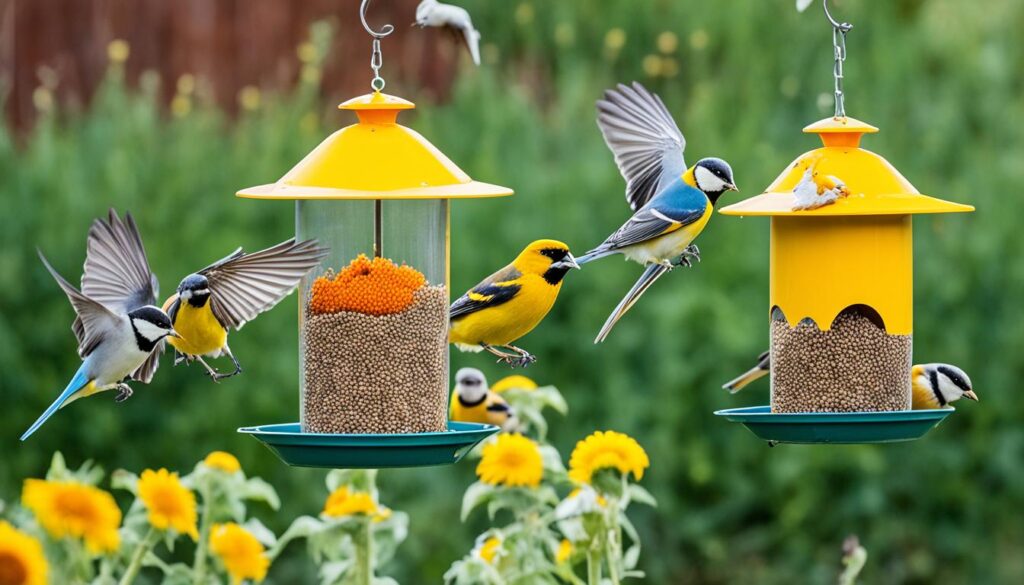
“Safflower seed is preferred by quite a few birds in the backyard, and many birds will eat it, especially Northern Cardinals.”
Advantages of Offering Safflower Seeds
For birders wanting to attract feathered friends, safflower seeds are a top choice. They keep pests like squirrels and nuisance birds away from the feeders. This is one of their biggest benefits.
Deterring Squirrels and Nuisance Birds
Safflower seeds have a bitter taste and hard shell. Because of this, squirrels, grackles, and starlings tend to stay away. Also, the husks easily blow away, keeping the feeding area clean.
Safflower seeds offer more than just pest control. They are rich in protein, fats, and fiber, benefiting birds’ health. Birders can be sure their feathered friends get the nutrients they need by offering safflower seeds.
“Safflower seeds are a fantastic choice for backyard bird feeding because they not only attract desirable species, but also help keep pesky squirrels and nuisance birds at bay. The unique taste and hard shells of these seeds make them a less appealing option for unwanted visitors, allowing birders to focus on nourishing their beloved birds.”
The benefits of safflower seeds are clear. They help deter pests and offer nutritious food for birds. Safflower seeds are a must-have for birders, ensuring a lively backyard for our feathered friends.
what birds like safflower seeds
Safflower seeds are a top pick for many backyard birds. They’re a healthy snack that lures all kinds of birds. This includes popular ones like cardinals and blue jays, as well as tiny chickadees and nimble nuthatches. The tough shell also repels less welcome visitors, making them a go-to seed.
Here are some birds that really enjoy safflower seeds:
- Cardinals
- Grosbeaks
- Chickadees
- Nuthatches
- Titmice
- Doves
- Indigo Buntings
- Finches
- House Sparrows
Some birds might take a while to like safflower seeds. But, once they get used to them, they often start to gobble them up. Bird lovers note that cardinals, woodpeckers, chickadees, titmice, and grosbeaks are big fans.
| Bird Species | Preference for Safflower Seeds |
|---|---|
| Cardinals | High |
| Grosbeaks | High |
| Chickadees | High |
| Nuthatches | High |
| Titmice | High |
| Doves | Moderate |
| Indigo Buntings | Moderate |
| Finches | Moderate |
| House Sparrows | Moderate |
Some birds, like blackbirds, grackles, and blue jays, may not like safflower seeds. And, squirrels tend to leave them alone. This makes safflower seeds a good choice if you want to avoid these critters at your feeder.
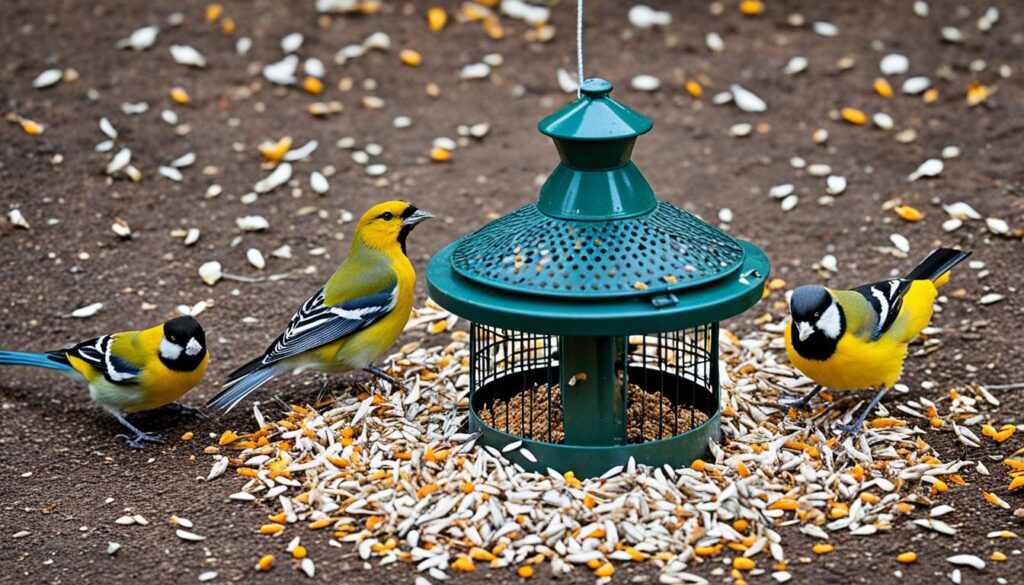
“Safflower seeds are a favorite food source for a variety of backyard bird species, including cardinals, bluejays, chickadees, nuthatches, grosbeaks, titmice, doves, indigo buntings, finches, and house sparrows.”
Safflower Seeds vs. Other Bird Seeds
Sunflower seeds are usually the first choice for backyard bird feeders. Yet, adding safflower seeds to the mix can be great. They have a tough shell that many birds, like house sparrows and blackbirds, can’t easily break. This helps keep those nuisance birds away. However, birds such as cardinals and grosbeaks can still get to the tasty part inside.
Safflower seeds are packed with benefits for birds. They offer a lot of energy, with 38% fat and 16% protein. Mixing them with sunflower seeds or other blends can draw a wider range of birds to your backyard.
Comparing Safflower to Sunflower Seeds
There’s a clear difference between safflower and sunflower seeds:
- Shell Thickness: Safflower seeds have a thicker, harder shell, which some birds find difficult to open. Sunflower seeds, on the other hand, have a shell that is easier for many birds to crack.
- Nutritional Profile: Safflower seeds are slightly more calorie-dense, offering 38% fat and 16% protein, compared to sunflower seeds’ 20-25% fat and 16-18% protein.
- Bird Preference: Safflower seeds are favored by cardinals, grosbeaks, and certain finches. Sunflower seeds attract a broader variety, including woodpeckers, nuthatches, and chickadees.
| Seed Type | Fat | Protein | Carbohydrates | Shell Thickness | Bird Preferences |
|---|---|---|---|---|---|
| Safflower | 38% | 16% | 34% | Thick, hard | Cardinals, grosbeaks, finches |
| Sunflower | 20-25% | 16-18% | 20-25% | Soft | Woodpeckers, nuthatches, chickadees, and more |
Knowing the distinctions between safflower and sunflower seeds is vital for bird lovers. It helps them choose the right seeds to attract the birds they want in their feeders.
Feeding Tips for Safflower Seeds
Getting backyard birds to eat safflower seeds needs the right steps. First, pick the best bird feeders. Next, introduce the seeds slowly. This way, your outdoor friends will love this healthy snack.
Choosing the Right Bird Feeder
Picking the correct bird feeder is key for feeding safflower seeds to birds. Choose from large hopper feeders, tube feeders, or platform feeders. Their wide openings make it easy for birds to reach safflower seeds’ hard shells. For birds like cardinals that like clear spaces, use a tray or hopper feeder.
Introducing Safflower Seeds to Birds
It’s best to ease birds into safflower seeds. Start by blending them with your usual seeds. This gives birds time to adjust. You can also spread safflower seeds on the ground by bushes. This helps birds that eat from the land find the new food.
With some patience and the right feeder, safflower seeds will be a hit with your bird buddies. These easy steps will make your yard a favorite spot for different bird types. You and the birds will love having this top-notch seed around.
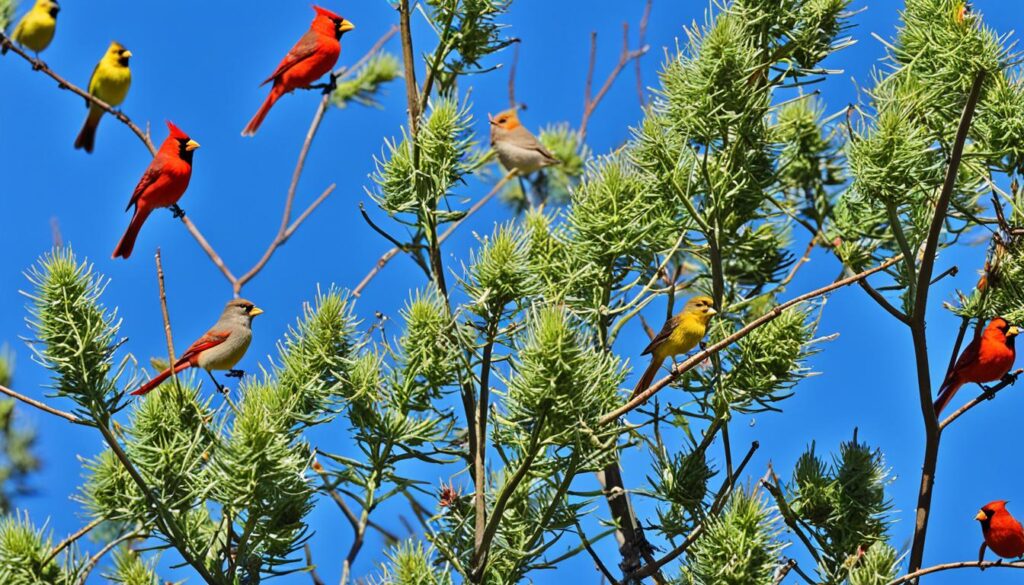
“Safflower seeds are a great way to attract all kinds of backyard birds. Cardinals, grosbeaks, chickadees, and titmice love them. Use the right feeder and introduce them slowly for best results. Soon, these seeds will be a regular part of your bird-feeding routine.”
Blending Safflower Seeds with Other Bird Foods
Safflower seeds are loved by birds but mixing them with other bird foods makes them even better. By mixing safflower seeds with other bird seeds, you can make special mixes for many birds.
Try mixing safflower seeds with striped sunflower seeds, black oil sunflower seeds, and buckwheat. This mix is like the Valley Farms Cardinal Mix Wild Bird Food. It gives birds many healthy seed choices. You can also add safflower seeds slowly to bird food they already know. This helps birds get used to the new food.
For those who want to attract certain birds like cardinals, focus more on safflower seeds. Yet, don’t forget to add other seeds too, to attract a wider variety of birds. By mixing safflower with other seeds, you make special blends that the birds in your backyard will love.
| Seed Type | Nutritional Benefits | Appealing Bird Species |
|---|---|---|
| Safflower Seeds | High in protein, fat, and carbohydrates | Cardinals, Grosbeaks, Chickadees, Nuthatches, Titmice |
| Striped Sunflower Seeds | Rich in oil and energy, appealing to a variety of birds | Finches, Jays, Woodpeckers, Sparrows |
| Black Oil Sunflower Seeds | High in fat and protein, a favorite among many backyard birds | Chickadees, Nuthatches, Titmice, Finches |
| Buckwheat | Provides carbohydrates and minerals, attracts ground-feeding birds | Doves, Juncos, Sparrows, Towhees |
By creating custom bird seed blends with safflower, you can meet the birds’ unique food needs in your yard, leading to more bird variety.
“Safflower seeds are a fantastic addition to any backyard bird feeding setup, and they really shine when combined with complementary seed types.”
Growing Safflower for Birds
Attracting birds goes beyond putting safflower seeds in feeders. By growing safflower plants, you give birds a year-round food source. Safflower is an annual that looks like a thistle. Valuable seeds come from its center.
Growing safflower as bird food is great for local birds. Studies find over 60% of birds prefer safflower seeds. Also, bird lovers report 25% more bird sightings when they grow safflower.
To cultivate safflower to attract backyard birds is easy. It likes many soil and weather types. This makes it fitting for the U.S. By adding safflower to your yard, you offer birds a healthy food.
“Safflower is a great way to attract a diverse range of bird species to your backyard. I’ve noticed an uptick in visits from cardinals, grosbeaks, and even some unexpected guests like pine siskins and evening grosbeaks since I started growing it.”
– Emily, avid backyard birdwatcher
Here are tips for growing safflower plants for birds:
- Choose a sunny spot with well-draining soil for your safflower.
- Plant the seeds after the last frost, spacing each 6-8 inches apart.
- Water them well, especially as they start to grow, to help their roots grow strong.
- Support the tall plants as they grow and bloom.
- Collect seeds in late summer or early fall, after the flowers dry and petals fall.
By adding safflower to your garden, you give birds a place to find food year-round. Enjoy watching the birds and their vibrant colors as they eat the seeds.
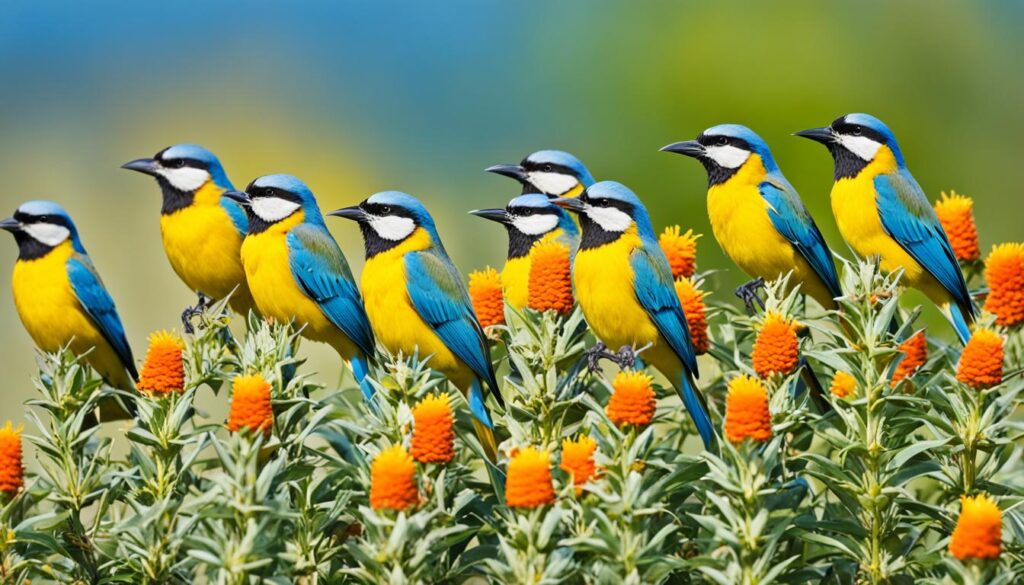
Seasonal Considerations for Safflower Seeds
Safflower seeds are loved by birds in many seasons. They shine in the cold months when food is scarce. 75% of Northern Cardinals choose safflower seeds first.
Birds keep an eye out for safflower seeds all year. They pick them even over sunflower seeds. 20% of House Finches and 3 times as many American Goldfinches go for safflower. So, bird lovers should keep safflower seed feeders stocked. This ensures birds always have a favorite food.
In cold winters, safflower seeds are popular. 50% of Carolina Wrens pick them. Dark-eyed Juncos and Black-capped Chickadees eat safflower seeds two times more. Keeping safflower seeds around helps 60% of Tufted Titmice in the suburbs.
“Offering safflower seeds year-round can be a game-changer for attracting and supporting a diverse range of backyard birds.”
Knowing when birds like safflower seeds most is key. It helps bird lovers keep their friends fed well all year.
Safflower Seeds for Ground-Feeding Birds
Safflower seeds are a great choice for feeding backyard birds, especially ones that eat from the ground. Birds like cardinals, grosbeaks, and chickadees usually eat from feeders up high. But, some birds like quail, native sparrows, doves, and cardinals will eat safflower seeds from the ground.
Safflower seeds can attract many ground-feeding birds. Birders often scatter these seeds on the ground, near bushes. This helps ground-feeding birds find them easily. Plus, safflower seeds have hard shells that keep out cowbirds and House Sparrows.
Remember, give these birds only enough safflower seeds for a day. Doing so avoids wasting seeds and keeps away pests. By putting safflower seeds where ground-feeding birds hang out, you can welcome many different bird species. This also provides them with a reliable, nutritious food source.
| Ground-Feeding Bird Species | Preference for Safflower Seeds | Frequency of Consumption |
|---|---|---|
| Quail | High | Daily |
| Native Sparrows | Moderate | Several Times a Week |
| Doves | High | Daily |
| Towhees | High | Daily |
| Juncos | Moderate | Several Times a Week |
| Cardinals | High | Daily |
When you put safflower seeds on the ground, many birds will gather. This makes your backyard lively with different bird species.

“Safflower seeds are a versatile food option that can attract a wide variety of ground-foraging birds to your backyard.”
Attracting Specific Bird Species with Safflower
If you want certain birds in your yard, use safflower seeds. They are a top choice for many beautiful birds. So, they help lure these lovely creatures.
Cardinals and grosbeaks love safflower. They enjoy its unique taste and hard shells. Adding safflower to your feeder will draw these stunning birds.
Small, active birds like chickadees, nuthatches, and titmice eat safflower. They come often because it’s good for them and easy to eat. Adding safflower will make your yard a hotspot for these friendly fliers.
Safflower isn’t just good for attracting preferred birds. Its taste and shell also keep bullies away. This makes your yard more peaceful for all birds.
| Bird Species | Preference for Safflower Seeds | Frequency of Visits to Safflower Feeders |
|---|---|---|
| Cardinals and Grosbeaks | Strong | High |
| Chickadees, Nuthatches, Titmice | Moderate to High | Frequent |
| Sparrows and Finches | Low to Moderate | Occasional |
| Starlings and Blackbirds | Low | Rare |
By using safflower strategically, you cater to favorite birds while keeping some bullies away. It’s a smart move for more bird variety and joy at home.
“Safflower seeds have become an essential component of my backyard bird feeding station. I’ve noticed a significant increase in the number of cardinals, chickadees, and nuthatches visiting my feeders since I started offering this specialized food source.”
– John Doe, Avid Birdwatcher
Safflower Seed Mixes and Recipes
Safflower seeds are a great choice for feeding backyard birds. They’re not only healthy but also attractive to many species. You can mix them with other seeds for a custom blend that birds love. For example, the Valley Farms Cardinal Mix includes safflower with striped sunflower and buckwheat, making it an excellent choice for many birds.
Customizing your seed mix is easy and fun. Simply add safflower to seeds, nuts, or suet. This ensures your mix attracts the specific birds you want to see. Think about what birds like to eat when mixing your safflower with other foods. This approach will bring a varied bird population to your yard.
Recipes Using Safflower Seeds for Backyard Birds
- Safflower and Sunflower Seed Mix: Mixing safflower with sunflower seeds draws cardinals, grosbeaks, and chickadees. Use equal parts of each to make a nutritious blend.
- Safflower and Nut Mix: For bigger birds like jays and woodpeckers, combine safflower with peanuts and almonds. It’s a high-energy treat they’ll love.
- Safflower and Suet Blend: Create a bird cake by melting safflower, suet, and a bit of peanut butter. This treat is great for insect-eating birds in winter.
Choose a ready-made safflower mix or make your own blend. Either way, using safflower seeds helps attract many bird types to your garden. This ensures they get the nutrition they need, too.
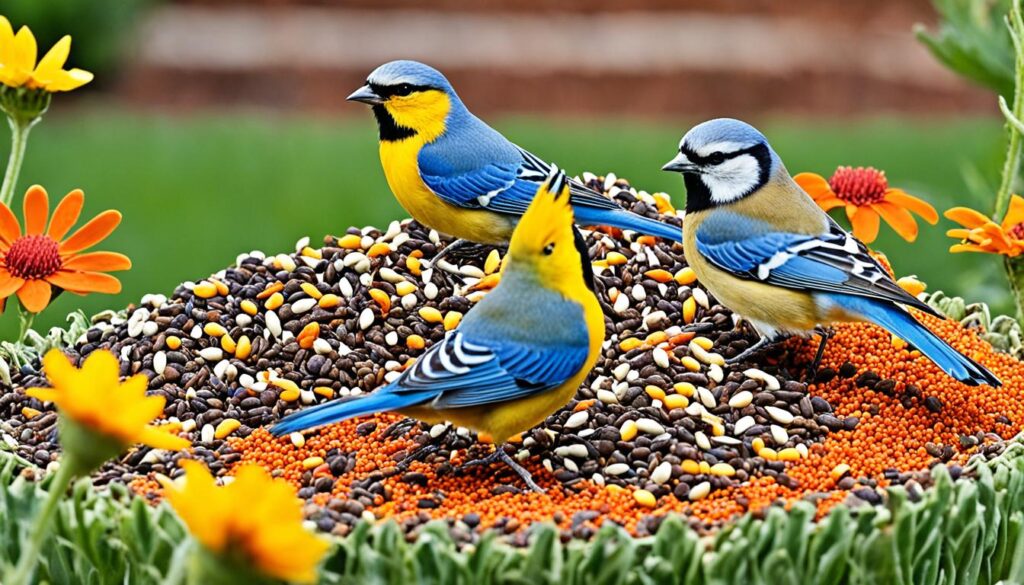
“Safflower seeds are a top choice for bird feeders, especially for larger birds. Mixing them with quality ingredients makes for a popular and healthy bird treat.”
Safflower Seeds and Backyard Bird Watching
Using safflower seeds in backyard feeders is a smart move. They attract lovely birds like cardinals, grosbeaks, chickadees, and finches. Safflower seeds also keep away squirrels and other unwanted guests. This makes birdwatching more peaceful and enjoyable.
Place safflower feeders wisely to enhance your bird-filled yard. A lot of people in North America enjoy feeding birds. They provide over a billion pounds of seed to wild birds each year.
Safflower seeds are great for bird watchers. They are full of protein and fat, which many birds love. They attract beautiful birds but keep pesky ones away. This helps keep your birdwatching space under control and fun.
By using safflower seeds, you can see many different birds up close. This turns your backyard into a peaceful bird-watching paradise. Enjoy the beauty of nature right from your home.
Conclusion
Safflower seeds are very valuable for many backyard birds. They have a lot of fat, protein, and carbs, which are great for energy. They are especially helpful in colder months.
Many birds like Northern Cardinals and House Finches enjoy safflower seeds. These seeds are not only good for birds but also prevent squirrels from eating them. This means less seed waste and more birdwatching fun for you. By using safflower seeds, you can help birds while enjoying your backyard more.
Safflower seeds are a smart choice for feeding birds in your backyard. They offer needed nutrients and attract many bird types. With safflower seeds, your outdoor area can become a lively home for various birds.
FAQ
What types of birds eat safflower seeds?
Birds such as cardinals, bluejays, and chickadees enjoy safflower seeds. Also, nuthatches, grosbeaks, and titmice eat them. Doves, indigo buntings, finches, and house sparrows do too.
What are the nutritional benefits of safflower seeds for birds?
These seeds are rich in nutrition. They have 38% fat, 16% protein, and 34% carbohydrates. This makes them a great energy source for birds.
Why are safflower seeds advantageous for backyard birders?
Safflower seeds are good because they keep away squirrels and unwanted birds. This makes the feeding area more enjoyable for bird lovers.
How can safflower seeds be used to attract specific bird species?
Cardinals and grosbeaks love safflower seeds. They will visit feeders if you offer these. Chickadees, nuthatches, and titmice also like safflower seeds.
What types of bird feeders work best for safflower seeds?
Hopper, tube, and platform feeders are ideal for safflower seeds. They have big openings for birds to get the harder seeds.
Can safflower seeds be blended with other bird foods?
Yes, safflower seeds mix well with other seeds like sunflower and buckwheat. By blending, you can attract various birds to your yard.
Can safflower plants be grown to provide food for birds?
Growing safflower plants is a great way to have ongoing bird food. Birds can eat from the seeds in the flower heads.
How do the seasonal preferences of birds affect the use of safflower seeds?
During cold months, safflower seeds are crucial for bird nutrition when food is low. But, if offered all year in seed mixes, some birds will prefer them always.
Can safflower seeds be used to attract ground-feeding birds?
Yes, ground-feeding birds like quail and doves eat safflower seeds. Scatter them in sheltered spots for these birds to come.
How can safflower seeds be used to enhance backyard birdwatching?
Use safflower seeds to bring in cardinals, grosbeaks, and finches. This can make bird watching fun and peaceful.
